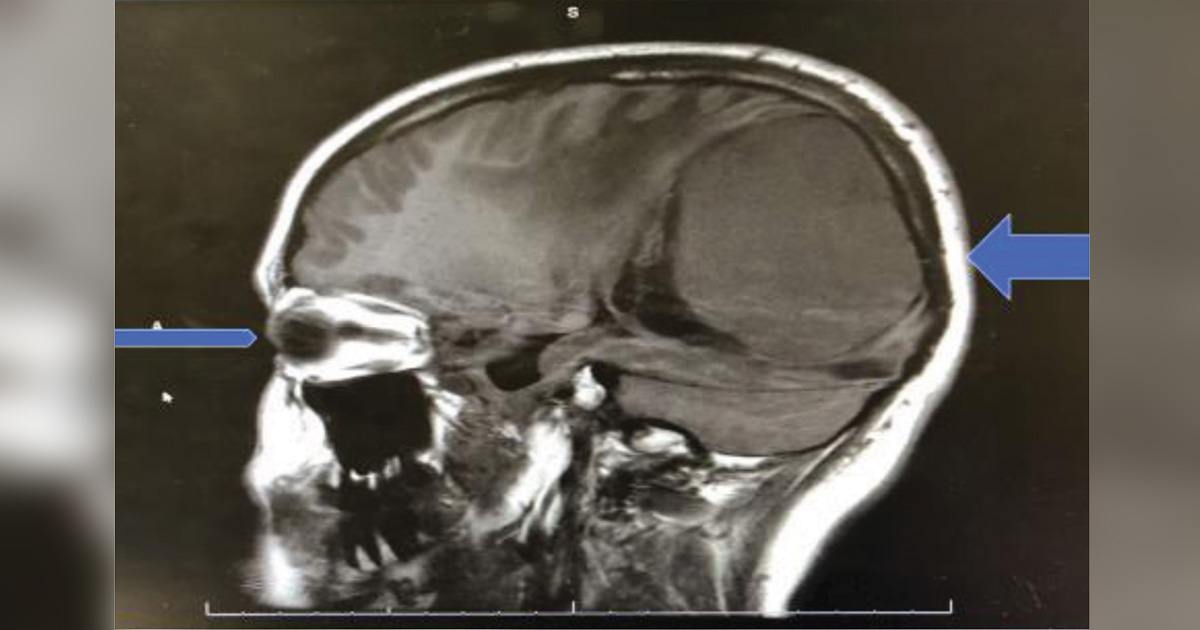Normal pupils, discs, fields may not rule out brain tumors
Most ophthalmic educators stress the importance of pupils — excluding relative afferent pupillary defect — along with careful assessment of disc borders and confrontation visual fields to rule out optic nerve and visual pathway disorders.
In my review of more than 400 cases of alleged malpractice over four-plus decades, at least five cases of patients with large brain tumors have been identified who had normal pupils, discs and confrontation fields. A review of the three most educational cases follow. Cases 2 and 3 date back to the 1990s, hence many younger practitioners may not have been exposed to either.

Case 1
The most recent case was published last year in Primary Care Optometry News. This unfortunate teenager presented with vague symptoms of flashing lights and headaches on four yearly visits to her eye care provider (and myriad other times to her pediatrician, gynecologist and to ENT). Visual acuity was 20/20 OU at all four visits. Her pupils, the fundus exam (including disc assessment) and confrontation visual fields were also recorded as normal.
Remarkably, only 9 months following her last “normal” visit to her eye care provider, she presented to an emergency department and was found to have a brain mass nearly a third the size of the cranium. Surgery and radiation for the meningioma were considered successful, but she is now nearly blind and requires a guide dog. This recent case is still pending.
Case 2
Perhaps the best-known case that falls into this category – because of a giant jury award – relates to the diagnosis of amblyopia in another teenage girl. She presented with reduced vision in her right eye, occasional flashes in her right eye and no neurological signs or symptoms. Best corrected visual acuity was 20/40 OD and 20/20 OS. The ECP found no refractive error in either eye; normal pupils; a dilated fundus exam revealing no disc, macula or other peripheral retinal abnormality; and normal confrontation visual fields. (The teenager and mom later testified that the doctor did perform confrontation visual fields.) His diagnosis, as explained to the teenager and her mom at the time was “lazy eye,” and neither glasses nor eye patching was recommended. A return visit was advised in 1 year.

Source: Jerome Sherman, OD, FAAO
Less than a year later, the teenager was in Spanish class when she experienced flashing colored lights for about 5 minutes, followed by dramatic loss of vision in her right eye. The exam the next morning by the same ECP revealed visual acuity of 20/800 OD and 20/20 OS but yet normal pupils, discs and macula. A consulting retinologist several hours later confirmed these findings.
An MRI was then obtained, which revealed a large pre-chiasmal mass. A world-class neurosurgeon and others recommended surgery as the only viable treatment option. The procedure apparently went well, but in the immediate postop period, hydrocephalus developed, and a shunt through the frontal lobe was deemed necessary to lower the elevated intracranial pressure.
The next morning, the teenager awoke after the two surgical procedures and the general anesthesia. Her visual acuity was no light perception in each eye and never returned. Shortly afterward, both discs were noted to be completely atrophic. This teenager is completely blind forever.
The lesson to be learned is that amblyopia is a diagnosis of exclusion. Be especially aware of those cases where an amblyogenic factor (the two most common of which are constant unilateral strabismus and significant anisometropia) is not documented. The jury trial in this case against the ECP resulted in a culpable verdict and a $9.2 million award.
Case 3
A middle-aged man presented with a chief complaint of blurred vision in both eyes. Best corrected visual acuity was 20/25 OU, and the external exam (reported to include pupils and confrontation visual fields) was normal, as was the fundus exam. The ECP reassured the patient that his slightly reduced vision was due to early cataracts and recommended another evaluation in 2 years. Four exams, in 1992, 1994, 1996 and 1998 all resulted in the same diagnosis. Minor changes in prescription helped somewhat.

The next year, with vision slightly worsening, the patient decided to get a cataract surgical consultation. The surgeon agreed that the cataracts were mild but obtained a screening visual field that revealed a bitemporal loss. An MRI uncovered a large pituitary adenoma. A consulting neurosurgeon recommended the relatively noninvasive trans-sphenoidal procedure to remove the mass. It failed, and then the neurosurgeon suggested the more invasive approach requiring “cracking the skull.” The patient agreed, had the surgery, but never regained consciousness and died in the hospital 29 days later.
The patient kept a health journal, documenting all his visits to various doctors, his complaints and the doctors’ findings and recommendations. In 1994, he documented his complaints as: blurred vision, worse in the left eye and in the left field of the left eye. This 1994 note was more detailed than the doctor’s records that indicated only blurred vision in both eyes as previously reported. It appears that the pupils, discs and confrontation fields were always normal, but automated visual fields were never obtained. The case was eventually settled for several million dollars, but the patient is dead.
Two additional cases
In two other cases of normal pupils, normal discs and normal confrontation visual fields, the patients had no symptoms suggesting a brain lesion and were eventually scanned only when obvious abnormalities were observed.

Malpractice litigation against the ECPs in these two cases were eventually dropped.
All five of these cases could have had a much more favorable outcome. A normal confrontation visual field often gives the doctor and patient a false sense of security. An automated visual field screener would most likely have identified defects indicating visual pathway involvement.
Note that both teenagers in Cases 1 and 2 complained of flashing lights. If no vitreal-retinal traction is observed and no apparent prodromal migraine is supported as the diagnosis, consider visual pathway compression as the etiology of the light flashes.
Bottom line: Do not depend on normal pupils, discs and confrontation visual fields to rule out brain lesions.
- For more information:
- Jerome Sherman, OD, FAAO, is a Distinguished Teaching Professor at the SUNY College of Optometry, in private practice at Omni Eye Surgery in New York and a member of the Primary Care Optometry News Editorial Board. He can be reached at: j.sherman@sunyopt.edu.
